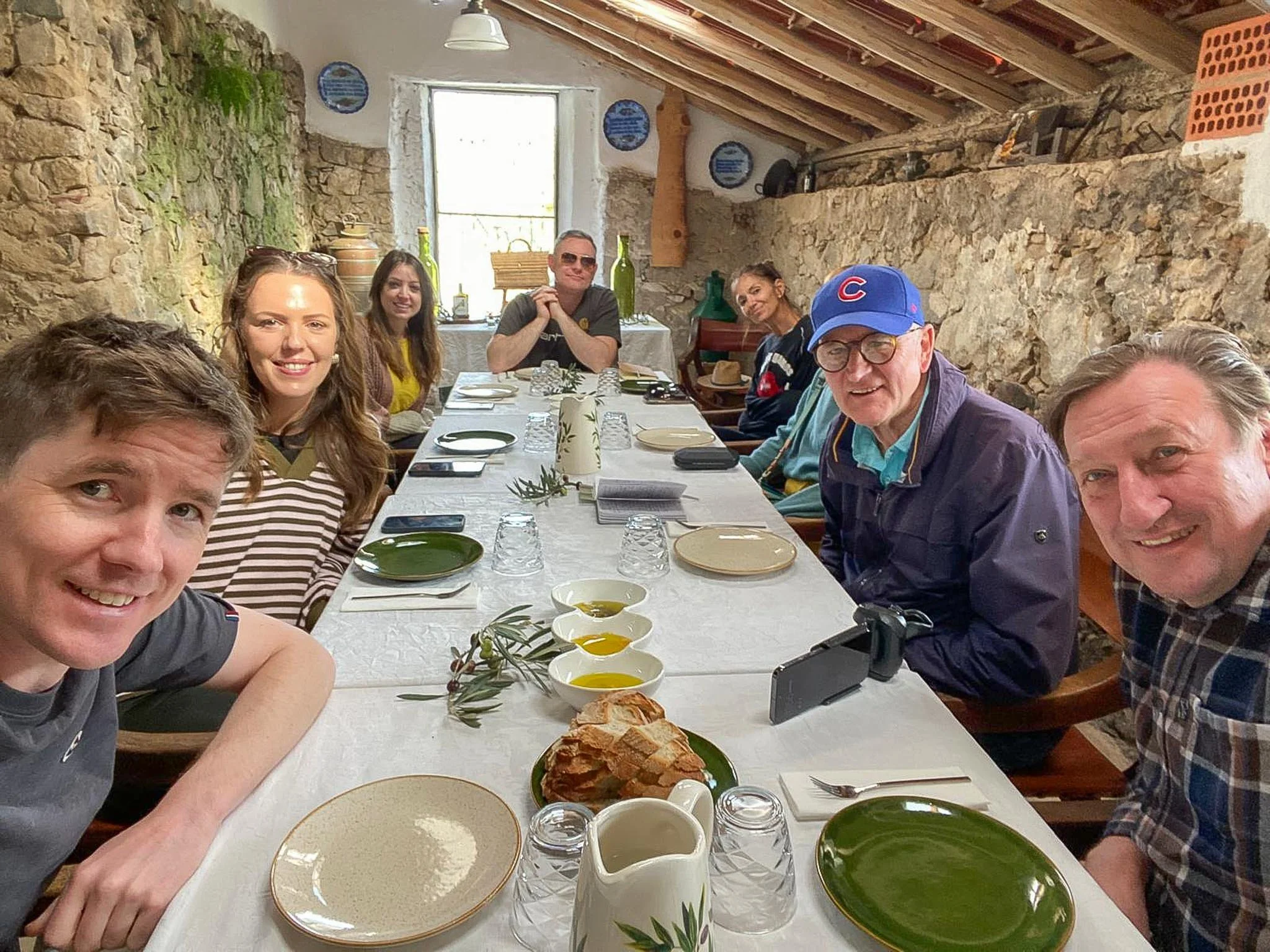Lagar dos Pardieiros Olive Oil Mill – Traditional and Modern Production in the Algarve Hills
Visiting an Olive Oil Producer in Monchique, Algarve
We were recently pondering a press trip to the Algarve and as part of the itinerary we visited the amazing Lagar dos Pardieiros olive oil producing business up in the high hills near the lovely little town of Monchique.
I was so taken by the amazingly hard-working and interesting Miguel de Figueiredo, who now runs the family business, that I thought we’d produce a special article here based on our visit and his talk…
Miguel de Figueiredo, Lagar dos Pardieiros
The Story of Lagar dos Pardieiros - Old and New
Miguel described the compelling contrast between the mill's historic, "old-fashioned" process (Factory 1, operating since 1952) and its new, automated facility (Factory 2). The core theme is the unwavering commitment to quality through freshness and traditional methods, even when those methods require immense physical effort and time.
Key Takeaways
Legacy Equipment & Philosophy
The old factory is powered by a reliable 1952 German engine. Miguel and his family maintain the founder's belief that while the old system is labor-intensive, it produces the best-tasting oil because the paste is never exposed to heat or excessive friction.
Grinding stones: Lagar dos Pardieiros
The Crucial Role of Freshness
The mill places extreme importance on processing olives within 24 hours of receiving them (or 48 hours of harvest) to prevent natural fermentation and oxidation, which would ruin the oil's quality. This is especially critical for the old factory.
The Traditional Cold Press
The old process involves grinding olives slowly (35–45 minutes) with heavy, local syenite stone millstones, which enhances the flavor. The oil is extracted using a true cold-press system: hydraulic pressure applied to stacked mats of olive paste, never exceeding 27 degrees C (the modern definition of cold press). This labour-intensive method sacrifices about 10% of the oil yield but ensures superior taste and quality.
Fresh olives: Lagar dos Pardieiros Olive Oil Mill
The New Factory (Automation and Efficiency)
The new facility was built out of necessity due to the difficulty of finding staff for the old, three-person system and the rising cost and scarcity of maintenance for the original machinery. The new factory is fully enclosed and automated, reducing the oxidation time from four hours down to 30 minutes. While it yields better chemical quality (lower acidity/oxidation), Miguel admits the taste of the oil from the old mill is still his personal favourite.
Sustainability and Waste
Everything is recycled. The solid waste (spent olive paste/pomace) is highly rich in organic matter and is composted for a year before being returned to fertilise the olive groves. The acidic liquid waste ("olive juice") is a chemical waste that is contained in an underground bacteria system before being collected by a specialised company.
Lagar dos Pardieiros Olive Oil Mill
Miguel de Figueiredo on the Legacy of Lagar dos Pardieiros
Miguel: “Our old factory is powered by the original engine from 1952, and it works every day without any problems. It's a German engine; it’s amazing. In Portugal, we never had to do maintenance—it’s the perfect thing to power the entire factory. It still works with a crank, so it takes a little bit of effort to start, but it’s a very good engine to power the old factory. I’m probably going to make a system so it can power a little bit of light in the new one, too, so the light bill doesn't go so high every day, but it’s fully connected and working.
Original engine still working: Lagar dos Pardieiros
In the other room, that’s where we receive the olives. In the beginning, in 1952, at the start of the season, they filled up the entire space with olives and worked until it was empty. We don't do that anymore. Now, we make a very serious effort to grind everything we receive in less than 24 hours (a top of 24 hours from us is key) to ensure that we grind olives that have been harvested in the last 48 hours. That’s very, very important for us, especially in the old factory. With the new one, we don’t have so much of an issue with oxidation, but in the old factory, we really have to work with fresh olives.”
Maintenance and Heritage in Portuguese Olive Oil Production
Maintenance & Heritage: The factory is so dedicated to its product that even the machinery maintenance uses olive oil as a lubricant (not standard engine oil), which allows them to detect leaks by taste and keeps the machine parts from rusting.
Lubrication cans: Lagar dos Pardieiros
“Our original stones were made here in Monchique and they are local syenite stones. That’s why we are able to make them last so long. Normally, millstones are made with limestone that needs to be replaced every 25 years. This is a quite heavy stone. Each one weighs about one and a half tonnes. They were put in here by hand. Right now, I don't have enough hands to do that. We have to take the full roof off if we have to replace these, just to put the machine in.
But it still serves a very important purpose for us. While we grind the olives, we take the taste from the proteins and fat. Grinding them very slowly without any friction or heating allows us to get the full taste of the olive in the paste. That’s very good if you have fresh olives. That’s not so good if you don't have fresh olives, because all bad tastes will still be there. We need to grind them for 35 to 45 minutes in here. We grind them entirely—peel, pit, seed, everything is fully grated—and we turn the olive basically into a mash, spreading it for the next step.”
Old press still in use: Lagar dos Pardieiros
The True Cold-Press Olive Oil Method
“This machine is a little bit older than me, and she’s going to have two jobs. First, she’s going to spread the paste and weigh it perfectly in here. But she’s also going to spin the paste for about 5 to 10 minutes so that the small molecules of olive oil can spread through the paste, they can merge, and we get bigger ones that will allow us to work better.”
“What we're going to do here is basically use the mats as a filter. We're going to create a lot of pressure in here. This is the true definition of cold press. Even though you see "cold press" on olive oils in supermarkets, they never use a system like this. This is a 100-ton press working on your olives. The good thing is we’ll be able to take the oil out without heating, and the pressure allows us to take the full taste of the olive. But we lose 10% of the olive oil we make the entire year just in this machine.
Pressure valves: Lagar dos Pardieiros
It’s one of the machines that requires the most maintenance. We fill the car up with mats and paste to the top - the axle and the weight of the car weigh one and a half tonnes. Pushing one and a half tonnes with liquid inside is not an easy job, but it’s important that when we lift it, the car is very centred for a couple of reasons. We’re going to power the entire press with that 1952 machine there. We have to disassemble that once every week just to do maintenance. We’re going to lift the car and press it against the top part of this machine at about 500 to 600 kilos in every square centimetre using here. One centimetre by one centimetre is going to be 500 kilos on it.”
“It doesn’t have a safety stop. Those little red lines that tell you: D on't go higher than that! Otherwise the machine will explode and a half-tonne part will fly to the roof? That has never happened here. One of the reasons was that people forgot the machine working after lunch, and the housing blew up. Worst-case scenario here is the pipes blow up, and you see water going through the sky.
Fresh olives waiting to be pressed
The machine works perfectly, and we’re going to separate solids from liquids here.”
"At the time when my grandpa started this factory, there were seven mills just in the Monchique area. Right now, there are three like this working in the whole of Portugal.”
“For us to test the quality of olive oil, we consider two things: the taste, which is important, but we also chemically consider the acidity level of the olive oil. Oxidation is another thing that affects the olive oil. In this factory, from the moment I start grinding the olives, up to the moment it’s inside the vats where we store it, it’s about four hours.”
Old office: Lagar dos Pardieiros
Transition to the New Factory in Monchique
Miguel: “The new factory is supposed to be way cleaner. It’s still a little bit messy, but it’s very different for another reason. Everything before this stage is just fresh washed olives, and now we’re going to do everything in an enclosed space. This big engine you see is our grinder, and we’re going to grind the olives as they’re coming in. Instead of 35 or 45 minutes of them being ground in open air with a lot of oxidation, you're going to have 20 minutes in here, and we start making olive oil.
In less than half an hour, we have ground the olives into olive oil. So, we pass from four hours of oxidation to 30 minutes—quite a difference.
This machine always makes better chemical results. In terms of taste, the other one has a very specific taste, and for me, that's what you taste—probably because I know how much work that one requires compared to this one. The old system needs three employees, or three family guys. That’s why it’s getting a little bit tricky. I can’t convince anyone to keep working with me.
“The only employee that I have is the electrical bill. It’s a little bit higher on these engines than on the other one, but we’re going to be able to do everything fully automated, and in terms of oxidation, it’s going to be less.”
Olive oil tasting: Lagar dos Pardieiros
“Nowadays, we consider cold press everything that is ground below 27°C. In this one, the lowest condition I can work with is 24°C because all the engines create friction. Basically, every machine that the olive passes through increases the temperature by two degrees. In the old factory, we start grinding them at 14°C to 15°C, and in the end, they are still at 14°C to 15°C. So, we lose a little bit of olive oil in the process because we don’t heat it up, but we end up with the full taste of the olive. In this new machine, we heat up a little bit more so we lose a little bit of taste here, but we end up with a more refined olive oil.”
Lagar dos Pardieiros
Visiting Lagar dos Pardieiros, Monchique
If you’re travelling in the Algarve and want to experience authentic Portuguese olive oil production, the hills of Monchique offer a glimpse into a living tradition.
At Lagar dos Pardieiros, you’ll meet a family who still believe in flavour over yield, patience over profit, and heritage over haste.
Hesp (right) at oil tasting:Lagar dos Pardieiros
















